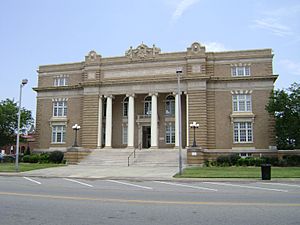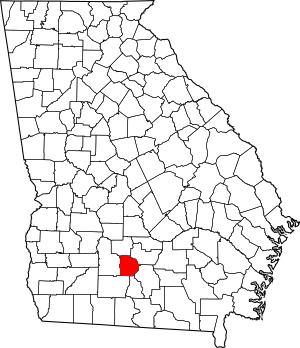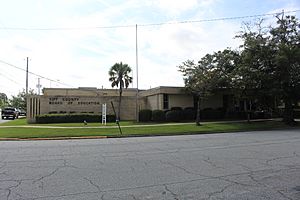Tift County, Georgia facts for kids
Quick facts for kids
Tift County
|
|
|---|---|

Tift County Courthouse, (Built 1912), Tifton
|
|

Location within the U.S. state of Georgia
|
|
 Georgia's location within the U.S. |
|
| Country | |
| State | |
| Founded | August 17, 1905 |
| Named for | Nelson Tift |
| Seat | Tifton |
| Largest city | Tifton |
| Area | |
| • Total | 269 sq mi (700 km2) |
| • Land | 259 sq mi (670 km2) |
| • Water | 9.9 sq mi (26 km2) 3.7%% |
| Population
(2020)
|
|
| • Total | 41,344 |
| • Density | 160/sq mi (60/km2) |
| Time zone | UTC−5 (Eastern) |
| • Summer (DST) | UTC−4 (EDT) |
| Congressional district | 8th |
Tift County is a county located in the south-central part of the U.S. state of Georgia. As of the 2020 census, about 41,344 people live there. The main city and county seat is Tifton.
Tift County is part of the Tifton, Georgia micropolitan statistical area. This means it is a smaller city area that is important for jobs and services in the region.
Contents
History of Tift County
The county was created on August 17, 1905. It is named after Henry Harding Tift. He founded the city of Tifton in 1872. Henry Tift bought a large area of pine forests, about 65,000 acres. He built a sawmill and a small village for his workers.
Henry Tift's businesses grew to include making turpentine and barrels. He also turned his forest lands into farms. These farms grew cotton, corn, and other crops. When two railroads met near Tift's mill in 1888, the area became a busy town. It was officially named Tifton by the Georgia Legislature in 1890.
Henry Tift helped the area grow by starting many businesses. These included the Tifton Cotton Mill and the Bank of Tifton. He also invested in fruit growing, grocery stores, and railroads. These businesses were very important for the development of the region. Tift also started a model farm and gave land for an agricultural experiment station. These efforts later led to the creation of Abraham Baldwin College and the Coastal Plain Experiment Station in Tifton.
Henry Tift also cared about his community. He gave land for churches and a park called Fulwood Park. He served as a city councilman and mayor for many years. Through his business and community work, Tift greatly helped the economy and society of south-central Georgia. He is remembered for his kindness and help to the community.
When Tift County was created in 1905, Georgia law did not allow a new county to be named after someone who was still alive. So, the legislature decided to name Tift County after Nelson Tift. He was Henry Harding Tift's uncle.
In 2013, a local author and historian, John Edward (Edd) Dorminey, helped to correct this. He worked with local and state leaders. The Georgia House of Representatives and Senate voted to officially name Tift County after its true founder, Henry Harding Tift.
Geography of Tift County
According to the U.S. Census Bureau, Tift County covers about 269 square miles. About 259 square miles of this is land. The remaining 9.9 square miles (3.7%) is water.
The western part of Tift County, west of Interstate 75, is in the Little River area. This river flows into the Suwannee River. The southeastern part of the county, from north of Tifton heading southeast, is in the Withlacoochee River area. This river also flows into the Suwannee River. The northeastern part of Tift County, east of Chula, is in the Alapaha River area, which is also part of the Suwannee River basin.
Major Highways in Tift County
Counties Next to Tift County
- Irwin County (northeast)
- Berrien County (southeast)
- Cook County (south)
- Colquitt County (southwest)
- Worth County (west)
- Turner County (northwest)
Communities in Tift County
Cities
Census-Designated Places
Unincorporated Communities
Population of Tift County
| Historical population | |||
|---|---|---|---|
| Census | Pop. | %± | |
| 1910 | 11,487 | — | |
| 1920 | 14,493 | 26.2% | |
| 1930 | 16,068 | 10.9% | |
| 1940 | 18,599 | 15.8% | |
| 1950 | 22,645 | 21.8% | |
| 1960 | 23,487 | 3.7% | |
| 1970 | 27,288 | 16.2% | |
| 1980 | 32,862 | 20.4% | |
| 1990 | 34,998 | 6.5% | |
| 2000 | 38,407 | 9.7% | |
| 2010 | 40,118 | 4.5% | |
| 2020 | 41,344 | 3.1% | |
| 2023 (est.) | 41,554 | 3.6% | |
| U.S. Decennial Census 1790-1880 1890-1910 1920-1930 1930-1940 1940-1950 1960-1980 1980-2000 2010 |
|||
| Race | Num. | Perc. |
|---|---|---|
| White (non-Hispanic) | 22,189 | 53.67% |
| Black or African American (non-Hispanic) | 12,049 | 29.14% |
| Native American | 56 | 0.14% |
| Asian | 650 | 1.57% |
| Pacific Islander | 2 | 0.0% |
| Other/Mixed | 1,179 | 2.85% |
| Hispanic or Latino | 5,219 | 12.62% |
At the 2020 United States census, there were 41,344 people living in Tift County. There were 15,144 households and 10,703 families.
Education in Tift County
The Tift County School District runs the public schools in the area.
See also
 In Spanish: Condado de Tift para niños
In Spanish: Condado de Tift para niños


